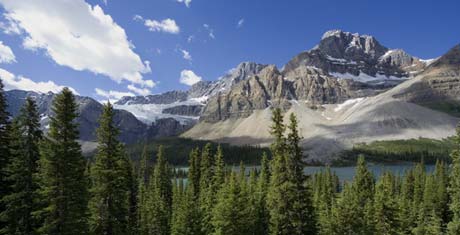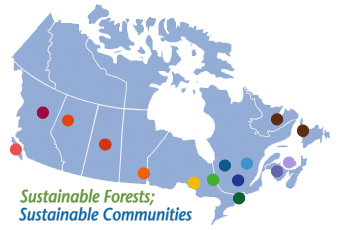Foothills Research Insitute
The Foothills Research Institute (FRI), encompassing 2.75 million hectares of western boreal, montane and sub-alpine forest, is located in west central Alberta. The FRI area includes Jasper National Park, Willmore Wilderness Park and the forest management areas of Hinton Wood Products, a division of West Fraser Mills Limited. The Foothills Research Institute develops projects in support of their 12 program themes, including for example, projects on the impacts of natural disturbances, the monitoring of grizzly bear populations and the socio-economic impacts of tourism in Alberta's national parks. In addition, Foothills is active in the areas of watershed planning, water quality and forest health. Learn More...
Bas-Saint-Laurent Model Forest
The Bas-Saint-Laurent Model Forest, encompassing 113,100 hectares of mixed forest in eastern Québec, is situated in the Lower St. Lawrence region between the St. Lawrence River and northern New Brunswick. The forest is dominated by stands of balsam fir, maple and yellow birch. The Model Forest is divided into three distinct areas: the Nicolas Riou and Lac-Métis seigneuries, both owned by Abitibi-Consolidated, totaling 47,620 hectares and Le Groupement forestier de l'Est du Lac Témiscouata area, totaling 65,000 hectares. Bas-Saint-Laurent is experimenting with two different and innovative forest management strategies: forest tenant farming and group management. Other project areas include wetland conservation, private woodlot certification and wildlife.
Long Beach Model Forest
The Long Beach Model Forest Society incorporated in 1994 and was a member of the Canadian Model Forest Network (CMFN) until the Society dissolved in 2002. Long Beach consisted of 400,000 hectares of coastal temperate rainforest located in the Alberni-Clayoquot Regional District on the western side of British Columbia 's Vancouver Island . The organization included First Nations and non-aboriginal communities, and consisted of 44 partner organizations that encompassed a diversity of interests in the area.
Several significant projects emerged from the Long Beach program, including a hydroriparian study in Clayoquot and Barkley Sounds to identify the ecological impacts of various riparian management practices on stream plants, amphibians and invertebrates.
An amphibian monitoring project to assess proposed buffer zones for amphibian riparian habitat compared the size of amphibian populations in areas bordering wetlands and streams in old-growth and clear cut areas. An amphibian inventory study helped land-use planning processes by defining land habitat features linked to high amphibian populations.
The association's Hahuulthi project researched and documented the values, knowledge and roles associated with the Hahuulthi system of the Nuu-chah-nulth in Clayoquot Sound. This project developed indicators that specifically addressed First Nations values and knowledge, and offered recommendations to regional planning bodies and agencies on how to apply a Nuu-chah-nulth-based resource management system.
This project engaged Nuu-chah-nulth people in the Long Beach Model Forest Program both as leaders and partners, and gave non-aboriginal partners a greater appreciation of First Nations approaches to resource stewardship.
McGregor Model Forest Association
The McGregor Model Forest Association (MMFA) was established in 1992. Over its 15-year history, the partnership evolved from an 180,000-hectare research area to a broader program that advanced sustainable forest management over 7.7 million hectares, including three of BC's major timber supply areas.
MMFA's diverse and innovative program included research, integrated forest management model development, forest education, and facilitation of collaborative decision-making. Fifty partner organizations represented communities, First Nations, industry, government and non-government agencies, individual scientists and practitioners, and created an innovative approach to sustainable forest management values, goals, and objectives through participatory and cooperative planning.
The association developed modeling and visualization tools that are still helping forest managers make long-term management and certification plans based on social, economic, and environmental factors. MMFA worked with the Omineca Beetle Action Coalition in dealing with the mountain pine beetle epidemic throughout the southern half of BC, provided information and services to resource-planning partners, and shared national CMFN projects with local communities and partners.
MMFA worked closely with international partners, including sustainable resource management planning initiatives with Russia 's Gassinski Model Forest , and a natural resource-based economic development project for the Khabarovsk Krai area of the Russian far east.
MMFA has evolved into the new Resources North program, which is building on McGregor's legacy with a new focus on forest community development.
Nova Forest Alliance
The Nova Forest Alliance (NFA) is a partnership of landowners, researchers, industry, First Nations communities, environmentalists, educational institutions, forest community areas, forest professionals and government. As Partners, we are committed to finding sustainable solutions for our forest communities. By bringing together a diverse group of organizations, we ensure all stakeholders have a voice in the future of Nova Scotia and Prince Edward Island forests.







